菲克第二定律
菲克定律

菲克定律菲克定律,是描述气体扩散现象的宏观规律,这是生理学家菲克(Fick)于1855年发现的。
包括两个内容:(1)早在1855年,菲克就提出了:在单位时间内通过垂直于扩散方向的单位截面积的扩散物质流量(称为扩散通量Diffusion flux,用J表示)与该截面处的浓度梯度(Concentration gradient)成正比,也就是说,浓度梯度越大,扩散通量越大。
这就是菲克第一定律。
(2)菲克第二定律是在第一定律的基础上推导出来的。
菲克第二定律指出,在非稳态扩散过程中,在距离x处,浓度随时间的变化率等于该处的扩散通量随距离变化率的负值。
菲克第一定律(Fick’s first law)早在1855年,菲克就提出了:在单位时间内通过垂直于扩散方向的单位截面积的扩散物质流量(称为扩散通量Diffusion flux,用J表示)与该截面处的浓度梯度(Concentration gradient)成正比,也就是说,浓度梯度越大,扩散通量越大。
这就是菲克第一定律,它的数学表达式如下: (1)式(1)中, D称为扩散系数(m/s),C为扩散物质(组元)的体积浓度(原子数/m或kg/m),dC/dx为浓度梯度,“–”号表示扩散方向为浓度梯度的反方向,即扩散组元由高浓度区向低浓度区扩散。
扩散通量J的单位是kg / m^2·s。
扩散系数扩散系数(Diffusion coefficient)D是描述扩散速度的重要物理量,它相当于浓度梯度为1时的扩散通量,D值越大则扩散越快。
对于固态金属中的扩散,D值都是很小的,例如,1000℃时碳在γ-Fe中的扩散系数D仅为10m^2/s数量级。
菲克定律里的稳态扩散和非稳态扩散菲克第一定律只适应于和J不随时间变化——稳态扩散(Steady-state diffusion)的场合(见图3.7-1)。
对于稳态扩散也可以描述为:在扩散过程中,各处的扩散组元的浓度C只随距离x变化,而不随时间t变化。
菲克定律

(1菲克第一定律 扩散流密度与扩散组元浓度梯度间关系称为菲克第一定律。
扩散流密度与在扩散介质中的浓度梯度成正比, 比例常数称为扩散系数。
菲克第二定律 稳态扩散特征是0dcdt =。
在物质的浓度随时间变化的体系中,即0dcdt≠,体系中发生的是非稳态扩散。
在一维体系中,单位体积单位时间浓度随的变化等于在该方向上通量,这既是菲克第二定律,其数学表达式为,A A x c t J x∂∂∂∂=)A A A( x c D t c x∂∂∂∂∂∂=若D A 为常数, 即可以忽略D A 随浓度及距离的变化,在x-y-z 三维空间中, 则菲克第二定律的表示式为(2)掌握 D 为常数时费克第二定律的几个特解扩散偶问题如图4-1-2初始条件 t=0,x >0,c =0 ; 边界条件 t >0, x =0, c =c 02; x =∞, c = 0解方程∂∂∂∂c t D cx =22,得 )d π21(22020ξξ⎰--=Dt xec c不同扩散时间后,扩散偶中扩散组元的浓度分布ξξd π2202⎰-Dt xe为积分函数 。
(式中Dtx 2=ξ)称为误差函数, 记作Dtx 2erf。
于是 )2e r f1(2),(0Dtx c t x c -=注:误差函数有如下主要性质 erf(x )=λλd π22-⎰exerf(-x )= - erf(x )erf(0)=0, erf(∝) =1 1-erf(x )= erfc(x )erfc(∝)=0, erfc(0)=1式中 erfc(x )称为余误差函数。
若初始条件变为t =0, x >0,c =c 1则解为 )2erf 1(2),(101Dtxc c c t x c --+= 几何面源问题数学模型1初始条件: t =0, x =0, c =c 0;x ≠0, c =0 Vc 0 =Q式中V − 极薄扩散源的体积; Q − x =0处扩散组元的总量。
如图4-1-2所示。
菲克定律原理范文
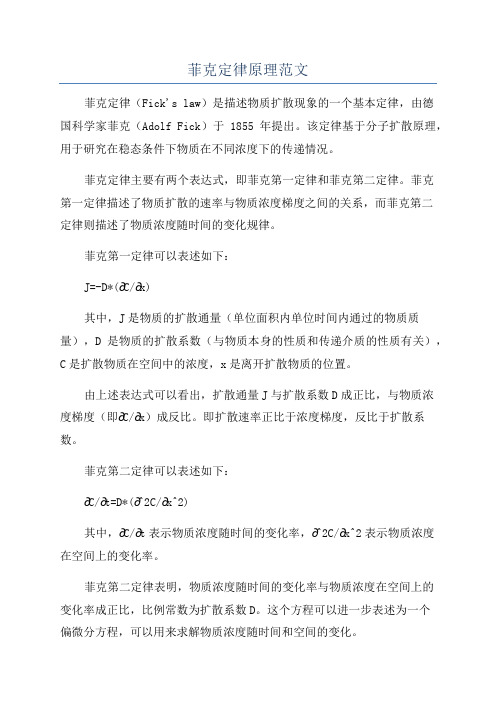
菲克定律原理范文菲克定律(Fick's law)是描述物质扩散现象的一个基本定律,由德国科学家菲克(Adolf Fick)于1855年提出。
该定律基于分子扩散原理,用于研究在稳态条件下物质在不同浓度下的传递情况。
菲克定律主要有两个表达式,即菲克第一定律和菲克第二定律。
菲克第一定律描述了物质扩散的速率与物质浓度梯度之间的关系,而菲克第二定律则描述了物质浓度随时间的变化规律。
菲克第一定律可以表述如下:J=-D*(∂C/∂x)其中,J是物质的扩散通量(单位面积内单位时间内通过的物质质量),D是物质的扩散系数(与物质本身的性质和传递介质的性质有关),C是扩散物质在空间中的浓度,x是离开扩散物质的位置。
由上述表达式可以看出,扩散通量J与扩散系数D成正比,与物质浓度梯度(即∂C/∂x)成反比。
即扩散速率正比于浓度梯度,反比于扩散系数。
菲克第二定律可以表述如下:∂C/∂t=D*(∂^2C/∂x^2)其中,∂C/∂t表示物质浓度随时间的变化率,∂^2C/∂x^2表示物质浓度在空间上的变化率。
菲克第二定律表明,物质浓度随时间的变化率与物质浓度在空间上的变化率成正比,比例常数为扩散系数D。
这个方程可以进一步表述为一个偏微分方程,可以用来求解物质浓度随时间和空间的变化。
菲克定律的应用非常广泛。
在材料科学中,菲克定律可以用来研究材料的扩散性能,如金属中的杂质扩散、气体或液体的渗透等。
在生物学中,菲克定律可以用来研究细胞内物质的传递,如细胞膜上溶质的扩散、细胞间物质的传递等。
此外,菲克定律还可以应用于环境工程、地球科学等领域。
总的来说,菲克定律是描述物质扩散现象的基本定律,它提供了研究物质传递过程的一种便捷方法,广泛应用于各个领域的科学研究和工程实践中。
1. Crank, J. (1975). The Mathematics of Diffusion. Oxford: Clarendon Press.2. Bird, R. B., Stewart, W. E., & Lightfoot, E. N. (2024). Transport Phenomena (2nd ed.). New York: Wiley.。
一般不考菲克第二扩散定律

一般不考菲克第二扩散定律摘要:1.菲克第一定律和第二定律的概述2.菲克第一定律的适用范围和条件3.菲克第二定律的适用范围和条件4.菲克第二定律与第一定律的关系5.菲克定律在混凝土中的应用举例6.结论正文:菲克定律是描述物质扩散过程的两个基本定律,分别是菲克第一定律和菲克第二定律。
其中,菲克第一定律适用于稳态扩散,而菲克第二定律适用于非稳态扩散。
然而,菲克第二定律是基于第一定律建立的。
菲克第一定律,也称为菲克唯象定律,它描述了物质在扩散过程中的速度与浓度之间的关系。
这一定律认为,物质的扩散速度与该物质在介质中的浓度成正比。
也就是说,物质在扩散过程中,其速度越高,浓度也就越高。
这一定律适用于稳态扩散,即物质在扩散过程中,其浓度是稳定的,不会发生浓度的突然变化。
菲克第二定律是基于菲克第一定律建立的,它描述了物质在非稳态扩散过程中的速度与浓度之间的关系。
非稳态扩散是指物质在扩散过程中,其浓度会发生突然变化。
菲克第二定律认为,在非稳态扩散过程中,物质的扩散速度与该物质在介质中的浓度的导数成正比。
虽然菲克第二定律是基于第一定律建立的,但它的适用范围与第一定律有所不同。
菲克第二定律适用于非稳态扩散,而第一定律适用于稳态扩散。
在实际应用中,菲克定律可以帮助我们理解和预测物质在介质中的扩散过程。
例如,在混凝土中,由于温度的不同,会导致混凝土内部的物质发生扩散。
在这种情况下,我们可以通过菲克定律来描述和预测物质在混凝土中的扩散过程。
由于混凝土可以被近似地看作一个无限延伸的介质,因此我们可以将菲克第二定律应用于混凝土中,以预测物质在混凝土中的扩散速度和浓度。
总之,菲克定律是描述物质扩散过程的两个基本定律,分别是菲克第一定律和菲克第二定律。
虽然这两个定律都适用于物质扩散过程,但它们的适用范围和条件有所不同。
菲克第二定律和非稳态扩散,菲克第二定律的误差函数解Notes_7-20

8
课件(七)
7. 强化玻璃
研究玻璃的科学家已经用玻璃成功制备了可以被锤子敲打或从高建筑物中摔 下而不被摔碎的物体。有两种技术应用于玻璃的强化—物理方法和化学方法。而 这两种理论都建立在一个事实上:当表面存在很小的缺陷(微小的刮痕)时,玻 璃在压缩时保持很大的强度,但在拉伸时很脆。因此,通过预加压的强化处理让 物体的外表面形成压缩应变使得玻璃能够抵消拉伸的张力。
(a)化学稳定
因为玻璃原子都已被完全氧化,所有玻璃都是抗氧化(衰减)的。由100% 硅四面体组成的玻璃是惰性的。它能够抵抗很多酸的腐蚀(氢氟酸例外,它被用 来蚀刻玻璃),但它却能够被强碱侵蚀。(装碱溶液的化学试剂瓶的表面不透明。)
(b)传导性
材料的导电能力由导带中电子决定。玻璃中导带与价带之间的带隙大约为 10eV。因为电子在玻璃中被紧密地束缚,所以玻璃的导电性能很差—实际上, 由于巨大的能隙,玻璃是很好的绝缘材料。玻璃也是很差的导热体。因此,当冷 水遇到普通热玻璃时,玻璃很可能破裂,因为接触到冷水的表面会收缩而内部却 没有发生变化。
图3 熔体“纺织”生产金属玻璃
另一种制备金属玻璃的方法是在接近80K的底板上真空沉积。同样地,纯净 的金属在这些情况下会结晶,但是某些合金会形成玻璃,而且即使是在室温下金 属玻璃也是稳定的。一个例子就是银-铜合金系统,银铜只有大约8%的互溶性。 如果熔体中含有50%质量分数银和50%质量分数的铜,并缓慢冷却,就会形成2 个晶相。当同样的合金通过真空沉积,就会形成亚稳态的金属玻璃。最初,这种 玻璃具有与液体合金相比拟的导电性。当玻璃在380K时保温半个小时以后,它 转变成为一种亚稳定面心立方固溶体晶体。只有加热到大约500K时,两相结构 的平衡才能形成。而很多纯净的非金属元素比如S,Se,Ge和Si在适当的情况 下也能形成稳定的玻璃。
菲克定律
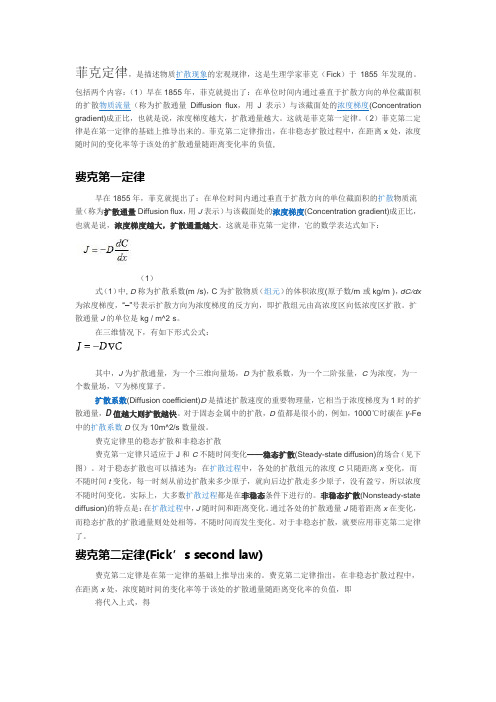
包括两个内容:(1)早在1855年,菲克就提出了:在单位时间内通过垂直于扩散方向的单位截面积律是在第一定律的基础上推导出来的。
菲克第二定律指出,在非稳态扩散过程中,在距离x处,浓度随时间的变化率等于该处的扩散通量随距离变化率的负值,费克第一定律早在1855年,菲克就提出了:在单位时间内通过垂直于扩散方向的单位截面积的扩散物质流量(称为扩散通量Diffusion flux,用J表示)与该截面处的浓度梯度(Concentration gradient)成正比,也就是说,浓度梯度越大,扩散通量越大。
这就是菲克第一定律,它的数学表达式如下: (1)式(1)中, D称为扩散系数(m²/s),C为扩散物质(组元)的体积浓度(原子数/m³或kg/m³),dC/dx 为浓度梯度,―–‖号表示扩散方向为浓度梯度的反方向,即扩散组元由高浓度区向低浓度区扩散。
扩散通量J的单位是kg / m^2·s。
在三维情况下,有如下形式公式:其中,J为扩散通量,为一个三维向量场,D为扩散系数,为一个二阶张量,C为浓度,为一个数量场,▽为梯度算子。
扩散系数(Diffusion coefficient)D是描述扩散速度的重要物理量,它相当于浓度梯度为1时的扩散通量,D值越大则扩散越快。
对于固态金属中的扩散,D值都是很小的,例如,1000℃时碳在γ-Fe 中的扩散系数D仅为10m^2/s数量级。
费克定律里的稳态扩散和非稳态扩散费克第一定律只适应于J和C不随时间变化——稳态扩散(Steady-state diffusion)的场合(见下图)。
对于稳态扩散也可以描述为:在扩散过程中,各处的扩散组元的浓度C只随距离x变化,而不随时间t变化,每一时刻从前边扩散来多少原子,就向后边扩散走多少原子,没有盈亏,所以浓度不随时间变化。
实际上,大多数扩散过程都是在非稳态条件下进行的。
非稳态扩散(Nonsteady-state diffusion)的特点是:在扩散过程中,J随时间和距离变化。
fick定律扩散方程
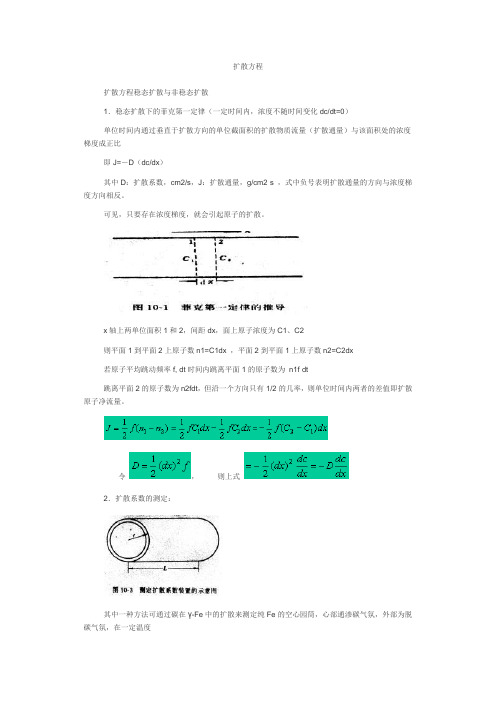
扩散方程扩散方程稳态扩散与非稳态扩散1.稳态扩散下的菲克第一定律(一定时间内,浓度不随时间变化dc/dt=0)单位时间内通过垂直于扩散方向的单位截面积的扩散物质流量(扩散通量)与该面积处的浓度梯度成正比即J=-D(dc/dx)其中D:扩散系数,cm2/s,J:扩散通量,g/cm2·s ,式中负号表明扩散通量的方向与浓度梯度方向相反。
可见,只要存在浓度梯度,就会引起原子的扩散。
x轴上两单位面积1和2,间距dx,面上原子浓度为C1、C2则平面1到平面2上原子数n1=C1dx ,平面2到平面1上原子数n2=C2dx若原子平均跳动频率f, dt时间内跳离平面1的原子数为n1f·dt跳离平面2的原子数为n2fdt,但沿一个方向只有1/2的几率,则单位时间内两者的差值即扩散原子净流量。
令,则上式2.扩散系数的测定:其中一种方法可通过碳在γ-Fe中的扩散来测定纯Fe的空心园筒,心部通渗碳气氛,外部为脱碳气氛,在一定温度下经过一定时间后,碳原子从内壁渗入,外壁渗出达到平衡,则为稳态扩散单位时单位面积中碳流量:A:圆筒总面积,r及L:园筒半径及长度,q:通过圆筒的碳量则:即:则:q可通过炉内脱碳气体的增碳求得,再通过剥层法测出不同r处的碳含量,作出C-lnr曲线可求得D。
第一定律可用来处理扩散中浓度不因时间变化的问3.菲克第二定律:解决溶质浓度随时间变化的情况,即dc/dt≠0两个相距dx垂直x轴的平面组成的微体积,J1、J2为进入、流出两平面间的扩散通量,扩散中浓度变化为,则单元体积中溶质积累速率为(Fick第一定律)(Fick第一定律),,,(即第二个面的扩散通量为第一个面注入的溶质与在这一段距离内溶质浓度变化引起的扩散通量之和)若D不随浓度变化,则故:4.Fick第二定律的解:很复杂,只给出两个较简单但常见问题的解a. 无限大物体中的扩散设:1)两根无限长A、B合?金棒,各截面浓度均匀,浓度C2>C1 2)两合金棒对焊,扩散方向为x方向3)合金棒无限长,棒的两端浓度不受扩散影响4)扩散系数D是与浓度无关的常数根据上述条件可写出初始条件及边界条件初始条件:t=0时, x>0则C=C1,x<0, C=C2边界条件:t≥0时, x=∞,C=C1, x=-∞, C=C2令,代入则,则菲克第二定律为即(1)令代入式(1)则有(2)若代入(2)左边化简有而积分有(3)令,式(3)为由高斯误差积分:应用初始条件t=0时x>0, c=c1,x<0, c=c2,从式(4)求得(5)则可求得(6)将(5)和(6)代入(4)有:,,,,,,,,,,,,上式即为扩散偶经过时间t扩散之后,溶质浓度沿x方向的分布公式,其中为高斯误差函数,可用表查出:根据不同条件,无限大物体中扩散有不同情况(1)B金属棒初始浓度,则(2)扩散偶焊接面处溶质浓度c0,根据x=0时,,则,若B棒初始浓度,则。
菲克第二定律怎么求扩散系数

菲克第二定律怎么求扩散系数嘿,朋友们,今天咱们聊聊扩散系数,尤其是菲克第二定律。
这东西听起来挺高深,实际上就像做饭一样,关键是掌握好火候。
别担心,咱们用最简单的语言来聊聊,让你轻松明白。
菲克第二定律其实是跟扩散有关的。
想象一下,咱们把一滴墨水滴进水里,墨水慢慢扩散开来,对吧?这就像是小朋友在水池里撒泡泡,一下子就能看见四处漂浮的泡泡。
这个扩散的速度和一些因素有关系,而扩散系数就是用来衡量这个速度的。
听起来是不是有点儿神秘?其实并不复杂,扩散系数就像是一把尺子,量一量扩散的“长短”。
你可能在想,咱怎么求这个扩散系数呢?好吧,这里有个简单的方法。
要知道你观察的是什么材料,温度又是多少。
温度就像是你喝茶的温度,热热的茶更容易让你提神,对吧?温度高,分子动得快,扩散也就快,这很简单。
咱们得用菲克第二定律的公式了,别紧张,这个公式其实就像你家里的调料方子。
每个调料都有比例,按照比例来,才能做出美味的菜。
咱们用的公式大致是这样的:扩散通量等于扩散系数乘以浓度梯度。
听起来复杂,其实就像你在厨艺比赛中,知道材料的分布情况,才能调出最合适的味道。
举个例子,想象一下你在厨房里调味,盐放多了味道就过咸了。
扩散系数越大,扩散的速度就越快,味道就能更快渗透进去。
然后,要用实验来求这个扩散系数。
想象一下,咱们在实验室里做实验,准备好一个透明的容器,里面装满了水。
然后,你把墨水滴进去,开始计时。
随着时间的推移,墨水慢慢扩散开。
你就像是在看一场魔术表演,观察它的变化。
记录下每个时间点墨水的浓度,最后通过这些数据,带入公式,就能算出扩散系数啦。
求扩散系数的时候,环境也很重要。
比如说,空气、液体、固体,它们的分子结构完全不同,扩散的速度自然也不一样。
像沙滩上的沙子,风一吹,沙子就四散而去;而水里的鱼,游动起来可比沙子快多了。
这时候,咱们就得根据不同的环境来调整实验的设计了。
扩散系数也和物质的性质有关。
像是有些物质,分子间相互作用强,扩散起来就比较慢;而有些物质,分子之间相对较“松散”,扩散就快得多。
扩散第二定律

扩散第二定律扩散第二定律是描述质点扩散过程中的扩散速率的物理定律,也被称为菲克定律。
它描述了在稳态条件下,质点由高浓度区域向低浓度区域扩散的速率是由浓度梯度决定的。
扩散是指由高浓度区域向低浓度区域自发地传播的现象。
当浓度不均匀存在时,质点会受到无规则的碰撞,从而发生随机运动。
扩散过程中,质点会由高浓度区域向低浓度区域移动,直到达到浓度均匀分布的稳态。
具体地,扩散第二定律可以用以下方程来表示:∂C/∂t = D * ∇²C其中,∂C/∂t表示浓度变化的时间导数,C表示浓度分布函数,D表示扩散系数,∇²表示拉普拉斯算子。
扩散第二定律描述了浓度分布随时间的变化规律。
扩散第二定律可以通过下面的推导得到:考虑一个一维的情况,即扩散发生在一个长度为L的导体中。
假设浓度梯度在x方向上为Grad(C),并假设扩散系数D是常数。
根据物质守恒定律,单位时间内从x处流出的物质量等于单位时间内通过x处横截面的物质量减去单位时间内通过x+Δx处横截面的物质量:J(x)ΔS - J(x+Δx)ΔS = - ∂C/∂t ΔV其中,J(x)表示单位面积横截面通过x处的物质流,ΔS表示横截面面积,ΔV表示长度为Δx的小段体积。
将上式展开并忽略二阶项,可以得到:-J(x)ΔS + [Δx∂(J(x)ΔS)/∂x] = - ∂C/∂t ΔV将J(x) = -D∂C/∂x代入上式,并取极限∆x趋近于0,可以得到:∂C/∂t = D∂²C/∂x²这就是一维情况下的扩散第二定律。
类似地,可以推导出二维和三维情况下的扩散第二定律:∂C/∂t = D(∂²C/∂x² + ∂²C/∂y²)∂C/∂t = D(∂²C/∂x² +∂²C/∂y² + ∂²C/∂z²)扩散系数D是一个与物质性质相关的常数。
它表示单位浓度梯度下的物质传递率。
菲克第二定律公式

菲克第二定律公式
弗雷德里克·菲克第二定律,又称“动量定律”。
它的定义是:受力
的结果,就是物体的任何变化的运动状态,有一个总的动量是保持不变的,即物体的动量在外力的作用下保持守恒,表达式为:
∆m * v₁·=∆ m * v₂+ F·∆t
其中,Δm为物体的质量变化量,v₁和v₂是物体质量前后的速度,F为
外力,Δt为物体发生变化的时间。
菲克第二定律意味着,通过施加外力使物体运动发生变化,物体的动
量总量是不变的。
因此,如果物体改变了运动状态,其受力的总结果将表
现为物体改变运动动量的大小(并非数量),而物体的质量不变。
言用简单,即“物体的动量保持守恒”,它是在把牛顿第二定律和第
三定律结合起来,表示当外力作用于物体时,其运动学状态将发生变化,
而物体的动量总量是不变的,即物体动量的总量在物体发生变化时是定值,这就是弗雷德里克·菲克第二定律。
菲克第二定律可以使人们更深入地理解运动规律,如对于拋物运动,
抛射物球运动等,物体的动量守恒是其运动的基本特征,用菲克定律的表
达式可以很有效地描述它们的运动。
菲克第二定律在物理学中有重要作用,
它也被广泛应用到物理学中一些复杂情况,如流体力学,等离子体物理等重要领域,以及描述化学反应和物体旋转运动的复杂动态系统中。
菲克第二定律
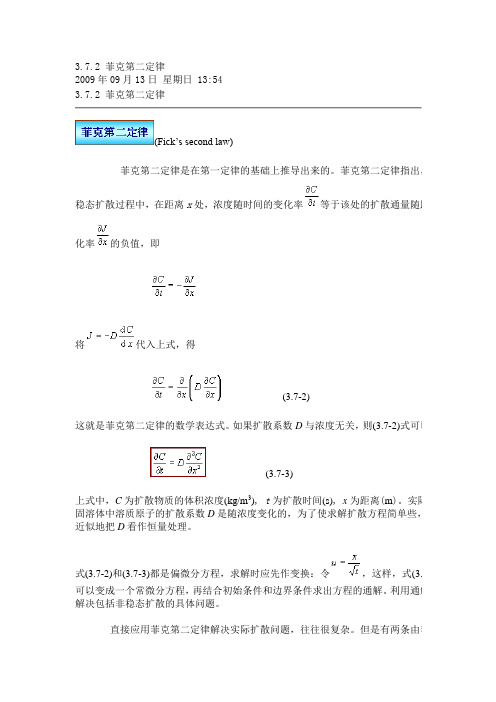
3.7.2 菲克第二定律
2009年09月13日星期日 13:54
3.7.2 菲克第二定律
(Fick’s second law)
菲克第二定律是在第一定律的基础上推导出来的。
菲克第二定律指出,在稳态扩散过程中,在距离x处,浓度随时间的变化率等于该处的扩散通量随距离化率的负值,即
将代入上式,得
(3.7-2)
这就是菲克第二定律的数学表达式。
如果扩散系数D与浓度无关,则(3.7-2)式可以写
(3.7-3)
上式中,C为扩散物质的体积浓度(kg/m3), t为扩散时间(s), x为距离(m)。
实际上固溶体中溶质原子的扩散系数D是随浓度变化的,为了使求解扩散方程简单些,往近似地把D看作恒量处理。
式(3.7-2)和(3.7-3)都是偏微分方程,求解时应先作变换:令,这样,式(3.7-3
可以变成一个常微分方程,再结合初始条件和边界条件求出方程的通解。
利用通解可解决包括非稳态扩散的具体问题。
直接应用菲克第二定律解决实际扩散问题,往往很复杂。
但是有两条由菲克
二定律推导出来的结论却十分简单、有用:
1.对于钢铁材料渗碳处理时,扩散需要的时间t与扩散距离x的平方成正比。
2.对于同一个扩散系统,扩散系数D与扩散时间t的乘积为一常数。
菲克第二定律的解
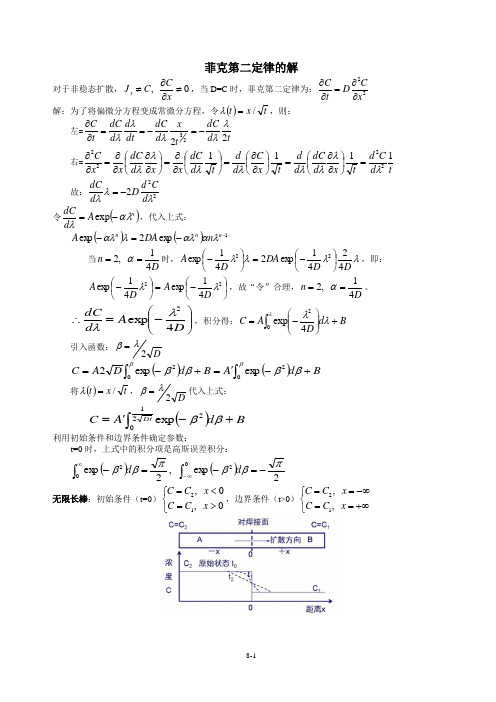
菲克第二定律的解 对于非稳态扩散,0,≠∂∂≠x C C J x ,当D=C 时,菲克第二定律为:22x C D t C ∂∂=∂∂ 解:为了将偏微分方程变成常微分方程,令()t x t /=λ,则: 左=td dC t x d dC dt d d dC t C 2223λλλλλ-=-==∂∂ 右=td C d t x d dC d d t x C d d t d dC x x d dC x x C 11112222λλλλλλλλ=⎪⎭⎫ ⎝⎛∂∂=⎪⎭⎫ ⎝⎛∂∂=⎪⎭⎫ ⎝⎛∂∂=⎪⎭⎫ ⎝⎛∂∂∂∂=∂∂ 故:222λλλd C d D d dC -= 令()n A d dC αλλ-=exp ,代入上式: ()()1ex p 2ex p --=-n n n n DA A λααλλαλ当D n 41,2==α时,λλλλD D DA D A 4241ex p 241ex p 22⎪⎭⎫ ⎝⎛-=⎪⎭⎫ ⎝⎛-,即: ⎪⎭⎫ ⎝⎛-=⎪⎭⎫ ⎝⎛-2241ex p 41ex p λλD A D A ,故“令”合理,D n 41,2==α。
⎪⎪⎭⎫ ⎝⎛-=∴D A d dC 4exp 2λλ,积分得:B d D A C +⎪⎪⎭⎫ ⎝⎛-=⎰λλλ024exp 引入函数:D 2λβ= ()()B d A B d D AC +-'=+-=⎰⎰ββββββ0202ex p ex p 2 将()t x t /=λ,D 2λβ=代入上式:()B d AC Dt +-'=⎰ββ2102exp 利用初始条件和边界条件确定参数:t=0时,上式中的积分项是高斯误差积分:()()2ex p ,2ex p 0202πββπββ-=-=-⎰⎰∞-∞d d无限长棒:初始条件(t=0)⎩⎨⎧>=<=0,0,12x C C x C C ,边界条件(t>0)⎩⎨⎧+∞==-∞==x C C x C C ,,12故:B A C B A C +'-=+'=2,221ππ2,222121C C B C C A +=-='∴π ()⎪⎭⎫ ⎝⎛-++=--++=⎰Dt x erf C C C C d C C C C C Dt 222exp 222212*********ββπ——无限长棒解 其中,()Dtx erf 2,=ββ为误差函数,可以查表得到。
一般不考菲克第二扩散定律
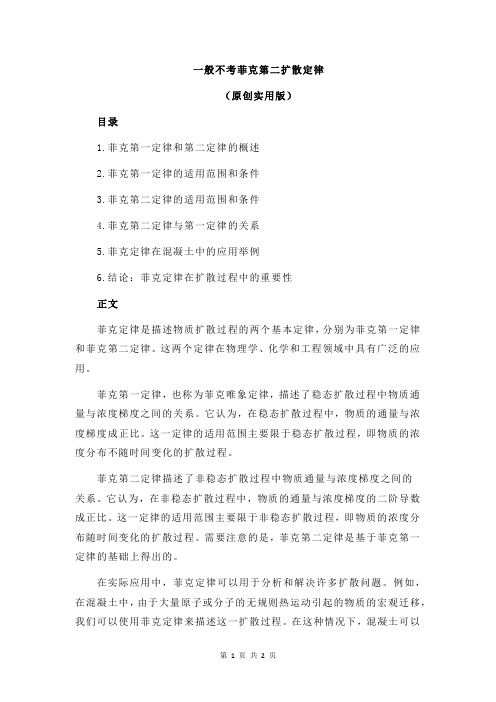
一般不考菲克第二扩散定律
(原创实用版)
目录
1.菲克第一定律和第二定律的概述
2.菲克第一定律的适用范围和条件
3.菲克第二定律的适用范围和条件
4.菲克第二定律与第一定律的关系
5.菲克定律在混凝土中的应用举例
6.结论:菲克定律在扩散过程中的重要性
正文
菲克定律是描述物质扩散过程的两个基本定律,分别为菲克第一定律和菲克第二定律。
这两个定律在物理学、化学和工程领域中具有广泛的应用。
菲克第一定律,也称为菲克唯象定律,描述了稳态扩散过程中物质通量与浓度梯度之间的关系。
它认为,在稳态扩散过程中,物质的通量与浓度梯度成正比。
这一定律的适用范围主要限于稳态扩散过程,即物质的浓度分布不随时间变化的扩散过程。
菲克第二定律描述了非稳态扩散过程中物质通量与浓度梯度之间的
关系。
它认为,在非稳态扩散过程中,物质的通量与浓度梯度的二阶导数成正比。
这一定律的适用范围主要限于非稳态扩散过程,即物质的浓度分布随时间变化的扩散过程。
需要注意的是,菲克第二定律是基于菲克第一定律的基础上得出的。
在实际应用中,菲克定律可以用于分析和解决许多扩散问题。
例如,在混凝土中,由于大量原子或分子的无规则热运动引起的物质的宏观迁移,我们可以使用菲克定律来描述这一扩散过程。
在这种情况下,混凝土可以
被近似地看作一个无限延伸的介质,即半无限均匀介质。
总之,菲克定律在扩散过程中具有重要意义,既可以描述稳态扩散过程,也可以描述非稳态扩散过程。
菲克定律公式

菲克定律公式:
菲克定律,是描述物质扩散现象的宏观规律,这是生理学家菲克(Fick)于1855年发现的。
包括两个内容:
1.早在1855年,菲克就提出了:在单位时间内通过垂直于扩散方向的单位截面积的扩散物质流量(称为扩散通量,用J表示)与该截面处的浓度梯度成正比,也就是说,浓度梯度越大,扩散通量越大。
这就是菲克第一定律。
它的数学表达式如下:
2.菲克第二定律是在第一定律的基础上推导出来的。
菲克第二定律指出,在非稳态扩散过程中,在距离x处,浓度随时间的变化率等于该处的扩散通量随距离变化率的负值。
它的数学表达式如下:。
菲克定律

7.1 扩散定律(1)7.1.1 菲克第一定律(Fick’s First Law)扩散过程可以分类为稳态和非稳态。
在稳态扩散中,单位时间内通过垂直于给定方向的单位面积的净原子数(称为通量)不随时间变化,即任一点的浓度不随时间变化。
在非稳态扩散中,通量随时间而变化。
研究扩散时首先遇到的是扩散速率问题。
菲克(A. Fick)在1855年提出了菲克第一定律,将扩散通量和浓度梯度联系起来。
菲克第一定律指出,在稳态扩散(即)的条件下,单位时间内通过垂直于扩散方向的单位面积的扩散物质量(通称扩散通量)与该截面处的浓度梯度成正比。
为简便起见,仅考虑单向扩散问题。
设扩散沿x轴方向进行(图7-1),菲克第一定律的表达式为(7-1)式中:J为扩散通量(atoms/(m2·s)或kg/(m2·s));D为扩散系数(m2/s);为浓度梯度(atoms/(m3·m)或kg/(m3·m)) (图7-2为浓度梯度示意图);“-”号表示扩散方向为浓度梯度的反方向,即扩散由高浓度向低浓度区进行。
此方程又称为扩散第一方程。
当扩散在稳态条件下应用(7-1)式相当方便。
7.1.2 菲克第二定律(Fick’s Second Law)实际上,大多数重要的扩散是非稳态的,在扩散过程中扩散物质的浓度随时间而变化,即dc/dx≠0。
为了研究这种情况,根据扩散物质的质量平衡,在菲克第一定律的基础上推导出了菲克第二定律,用以分析非稳态扩散。
在一维情况下,菲克第二定律的表达式为(7-2)式中:为扩散物质的体积浓度(atoms/m3或kg/m3);为扩散时间(s);为扩散距离(m)。
(7-2)式给出c=f(t,x)函数关系。
式(7-2)又称为扩散第二方程。
由扩散过程的初始条件和边界条件可求出(7-2)式的通解。
利用通解可解决包括非稳态扩散的具体扩散问题。
7.1.3 扩散方程的求解1. 扩散第一方程扩散第一方程可直接用于描述稳定扩散过程。
6.2 扩散的动力学方程

J=-D C x
此式表明:
(1) 扩散速率取决于 外因——C/ x
内因——扩散体系的性质 D
(2) D是一个很重要的参数: 单位浓度梯度、单位截面、单位 时间通过的质点数。
D取决于 质 点: 半径、电荷、极化性能等 基 质: 结构紧密程度 如CaF2存在“1/2立方空隙”易于扩散
有缘学习更多+谓ygd3076考证资料或关注桃报:奉献 教育(店铺)
三维表达式: 用途:
J= iJx jJ y kJ z
D(i
C
j
C
k
C
)
x y z
可直接用于求解扩散质点浓度分布不随时间变化的稳定扩散问题。
(3) 稳定扩散(恒源扩散)
C
C
C/ t=0
C/ x=常数
不稳定扩散
C C/ t0
6.2 扩散的动力学方程
1855年德国物理学家A·菲克(Adolf Fick) 参照了傅里叶(Fourier) 于1822年建立的 导热方程,并在大量实验和研究的基础 上,对在浓度场作用下物质的扩散作了 定量的描述,提出了研究物质扩散的菲 克第一定律和第二定律。
一、Fick第一定律
稳定扩散: 扩散质点浓度不随时间变化 C 0 t
有缘学习更多+谓ygd3076考证资料或关注桃报:奉献教育 (店铺)
菲克第一定律
一维表达式
J=-D C x
三维表达式 J
应用
稳定扩散
菲克第二定律 不稳定扩散
对二定律的评价:
(1) 从宏观定量描述扩散,定义了扩散系数,但没有给出D与结构的 明确关系;
(2) 此定律仅是一种现象描述,它将浓度以外的一切影响扩散的因素 都包括在扩散系数之中,而未赋予其明确的物理意义;
- 1、下载文档前请自行甄别文档内容的完整性,平台不提供额外的编辑、内容补充、找答案等附加服务。
- 2、"仅部分预览"的文档,不可在线预览部分如存在完整性等问题,可反馈申请退款(可完整预览的文档不适用该条件!)。
- 3、如文档侵犯您的权益,请联系客服反馈,我们会尽快为您处理(人工客服工作时间:9:00-18:30)。
Lecture 4: Diffusion: Fick’s second law
Today’s topics
•Learn how to deduce the Fick’s second law, and understand the basic meaning, in
comparison to the first law.
•Learn how to apply the second law in several practical cases, including homogenization, interdiffusion in carburization of steel, where diffusion plays dominant
role.
Continued from last lecture, we will learn how to deduce the Fick’s second law, and
understand the meanings when applied to some practical cases.
Let’s consider a case like this
We can define the local concentration and diffusion flux (through a unit area) at position “x”as:
So, Fick’s first law can be considered as a specific (simplified) format of the second law when applied to a steady state.
Now, let’s consider two real practical cases, and see how to solve the Fick’s second law in these specific cases.
Case 1. Homogenization: (non-uniform →uniform)
Consider a composition profile as superimposed sinusoidal variation as shown below, where the solid line represents the initial concentration profile (at t=0), and the dashed line represents the profile after time τ.
It is an exponential decay, the longer the wavelength (l), the longer the relaxation time (τ), then the slower decay. Short wavelength dies fast. That’s why shaking always helps speed up the dispersion, because it enables wide spreading (smaller l) of the stuff (like particles) you
try to disperse
Case 2. Interdiffusion (the carburization of steel):doping of steel with carbon
Situation a): Doping with fixed amount of dopant
Consider a thin layer of B deposited onto A, through annealing at high temperature, we will be able to get the concentration profile at different times, from there then we can determine the diffusion coefficient, D
as determined by this diffusion kinetics equation, the concentration profile of carbon as various times will be like this
The above diffusion is one-direction (0 →+∞). But if we extends it to two-way, from -∞to +∞(like a droplet dissolved into a solution) with dopant at x=0, then we have
Situation b): Doping with a fixed surface concentration (e.g. carburization of steel)
Carbon concentration profile shown at different times,
Carbonization thickness is defined as
The solution of the Fick’s second law can be obtained as follows, the surface is in contact
with an infinite long reservoir of fixed concentration of , choose a coordinate system u.
Interdiffusion is popular between two semi-infinite specimens of different compositions c1, c2, when they are joined together and annealed, or mixed in case of two solutions (liquids). Many examples in practice fall into the case interdiffusion, including two semiconductor interface,
metal-semiconductor interface, etc.。
